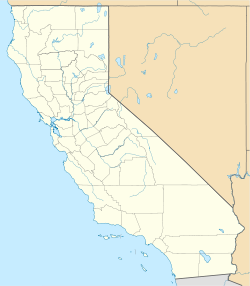Top Qs
Timeline
Chat
Perspective
Bear Valley, Mariposa County, California
Census-designated place in California, United States From Wikipedia, the free encyclopedia
Remove ads
Bear Valley (formerly Haydenville, Biddle's Camp, Biddleville, Simpsonville, and Johnsonville)[5] is a census-designated place in Mariposa County, California, United States.[2] It is located 10.5 miles (16.9 km) south-southeast of Coulterville,[5] at an elevation of 2,054 feet (626 m).[2] Bear Valley has been designated California Historical Landmark #331.[4] The population was 156 at the 2020 census.[3]
Remove ads
Remove ads
History
Summarize
Perspective
The place was originally called "Haydenville" in honor of David, Charles, and William Hayden, gold miners.[5] The place later bore the names "Biddle's Camp" and "Biddleville" in honor of William C. Biddle.[5] It later was named "Simpsonville" in honor of Robert Simpson, local merchant.[5] The name "Johnsonville" honored John F. Johnson.[5] The name became Bear Valley in 1858.[5]
The Haydenville post office opened before January 21, 1851, and closed in 1852.[5] The Bear Valley post office operated from 1858 to 1912, from 1914 to 1919, and from 1933 to 1955.[5]
In 1847, John C. Frémont, a veteran of the Bear Flag Revolt, decided to settle down in the San Francisco Bay Area. Desiring a ranch near San Jose, he sent $3,000 to the American consul Thomas O. Larkin. Instead of his intended purchase, he was sold Rancho Las Mariposas, consisting of 44,387 acres (179.6 km2) in the southern Sierra Nevada foothills around Bear Valley.[6] The original Mexican grant was a "floating grant", a grant of land for which the area was precisely given but the actual boundaries were left unspecified (usually due to inadequate surveys of the areas involved). After the beginning of the California Gold Rush in 1848, Fremont moved his grant's borders into the hills. Those hills proved to be lucrative, and his mining operations centered in Bear Valley.[7]
At its peak, Bear Valley had a population of 3,000. During 1850-60 when Frémont's Pine Tree and Josephine Mines were producing, Frémont built an elegant hotel, Oso House; the structure, like many in the area, burned in the late 19th century.[4] Frémont lived and worked in the city, and his large home was nicknamed the Little White House, coincidentally built two years after he was the first Republican Party candidate for US president; the home burned in 1866.[7]
Remove ads
Geography
Bear Valley is in west-central Mariposa County in the foothills of the Sierra Nevada. California State Route 49 passes through the community, leading southeast 11 miles (18 km) to Mariposa, the county seat, and northwest through the Merced River canyon 15 miles (24 km) to Coulterville. According to the United States Census Bureau, the CDP covers 2.44 square miles (6.32 km2), of which 0.001 square miles (0.64 acres), or 0.04%, are water.[1]
Remove ads
Demographics
Summarize
Perspective
The 2020 United States census reported that Bear Valley had a population of 156. The population density was 63.9 inhabitants per square mile (24.7/km2). The racial makeup of Bear Valley was 113 (72%) White, 0 (0%) African American, 7 (4%) Native American, 0 (0%) Asian, 0 (0%) Pacific Islander, 9 (6%) from other races, and 27 (17%) from two or more races. Hispanic or Latino of any race were 34 persons (22%).
The whole population lived in households. There were 49 households, out of which 16 (33%) included children under the age of 18, 29 (59%) were married-couple households, 1 (2%) was a cohabiting couple household, 14 (29%) had a female householder with no partner present, and 5 (10%) had a male householder with no partner present. 10 households (20%) were one person, and 7 (14%) were one person aged 65 or older. The average household size was 3.18. There were 39 families (80% of all households).
The age distribution was as follows: 56 people (36%) under the age of 18, 64 people (41%) aged 18 to 64, and 36 people (23%) who were 65 years of age or older. The median age was 33.0 years. There were 77 males and 79 females.
There were 62 housing units at an average density of 25.4 units per square mile (9.8 units/km2), of which 49 (79%) were occupied. Of these, 100% were owner-occupied.[24][25]
References
Wikiwand - on
Seamless Wikipedia browsing. On steroids.
Remove ads



